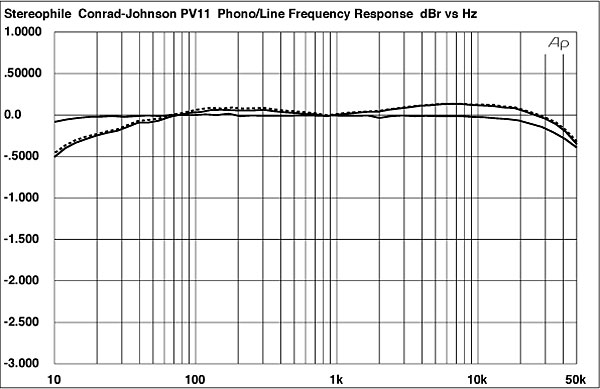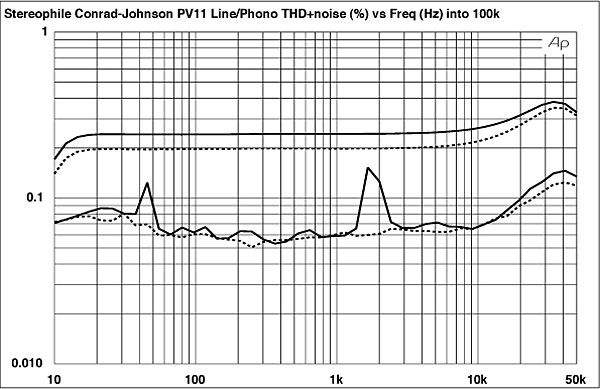| Columns Retired Columns & Blogs |
My first "real" high end system included a pv-7 and an mv-50. The sound was a little more colored than the competing(At the time) Audio Research stuff, but very musical.
Fig.1 shows the PV11's frequency response. The top curve (which becomes the lower curve below about 75Hz) shows the phono RIAA response taken from the tape outputs. Note the expanded scale. The RIAA EQ is accurate to within ±0.2dB from about 28Hz to 42kHz. The rise in the phono response above 1kHz may be audible as a slight brightening of the sound, but at less than 0.2dB it is insignificant when mated with the response of any phono cartridge that I know of. The same may be said of the small rolloff in the bass. Both channels are shown (solid and dotted lines), and were well matched. The remaining curve, for the line-level response (taken from the main outputs), was taken with the level control set for unity gain (about 11:30). The very small degree of rolloff noted at the high-frequency end decreases to about –0.1dB at 50kHz with the level set to either 9:00 or maximum (as does that at 10Hz at the other extreme). In any event, the response is flat across the audible range.

Crosstalk is shown in fig.2. The top curve indicates the crosstalk of the phono stage (essentially the same in both channels), the bottom curves the line-level crosstalk (the topmost of the bottom curves is the crosstalk from left to right, the lower the crosstalk from right to left). The line crosstalk curves were taken at the maximum setting of the level control; at lower level settings this crosstalk increased (at 11:30 or unity gain) to –71dB at 1kHz and –51dB at 10kHz. The increase in crosstalk at higher frequencies is generally due to capacitive coupling between channels; the increase at lower volume settings may be due to (low-level) broadband noise in the circuit following the level control, rather than crosstalk per se.

The (line stage) input impedance of the PV11 measured 43.3k ohms at 1kHz at maximum level, increasing slightly to just under 44.5k ohms at low (9:00) settings. Output impedance measured 676 ohms (left channel) and 655 ohms (right channel). Maximum line-stage gain was 17.4dB (left channel) and 17.9dB (right channel). Phono gain (to the tape outputs) was 47dB. Phono overload at 1kHz was 237mV (for 1% distortion), which gave 52V (!) at the tape output. At 20Hz, phono overload occurred at 9.63mV, and at 20kHz at 620mV, which is excellent.
A phono input of 1mV (1kHz) at full volume resulted in an output of 1.71V at the main outputs, implying a gain of 65dB and more than enough to drive most amplifiers. However, decreasing the input to 0.3mV (equivalent to the output of many low-level moving-coils) resulted in a rather noisy (on the oscilloscope) 514mV output. Some care should be taken when attempting to match the PV11 with a low-output moving-coil to insure that the overall system noise level is acceptably low for your situation and sensibilities.
The line-stage of the PV11 is inverting, the phono stage non-inverting—meaning that signals from the tape outputs will be non-inverted, and those taken from the main outputs will be inverted in absolute polarity (assuming a positive polarity signal to begin with).
Fig.3 shows the THD+noise vs frequency for the line-stage (top pair of curves, 100mV input, main outputs) and phono stage (bottom pair of curves, 5mV input, tape outputs). The line-stage curve shown was taken with the level control at maximum; reducing the level to unity gain (11:30) results in a distortion which remains below 0.04% across the band—except for a small rise to approximately 0.055% at 35kHz (which also drops below 0.04% with gain further reduced to the 9:00 setting). The 1% distortion level was reached with full volume and 3.1V input to the line-stage.—Thomas J. Norton


My first "real" high end system included a pv-7 and an mv-50. The sound was a little more colored than the competing(At the time) Audio Research stuff, but very musical.

It's been refurbed, re-tubed and upgaded with teflon caps but still going strong and sounding beautiful.